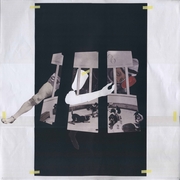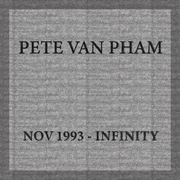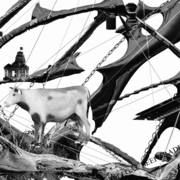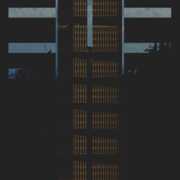POST
Post-Professional M.Arch Thesis Exhibition
March 29 - April 19, 2024
Cheryl Hazan Gallery, 35 N. Moore St, New York, NY 10013
Opening Reception: Friday, March 29, 2024, 6pm
Ongoing Public Viewing Hours: 12-6pm, Wednesdays - Sundays
Exhibition Statement
If barracks are blank, then representation fails.
If representation is real, then towers are solid.
If towers are eternal, then cemeteries are meaningful.
If cemeteries are displaced, then cowsheds are everywhere.
If cowsheds are broken, then enclosure is prosthetic.
If enclosure is inundated, then envelopes are packaged to go.
If envelopes are no more, then housing is fuzzy.
If housing is textile, then machines are inefficient.
If machines are dysfunctional, then memory is erased.
If memory serves, then barracks are moving.
The ten projects exhibited are conducted in the context of the Post-Professional M.Arch program at Princeton University School of Architecture where there is a unique opportunity for professionally trained architects to return to the university to pursue a two-year program culminating in a year-long thesis. The 2024 Post-Professional M.Arch Thesis class is coordinated by Professor Jesse Reiser.
PROJECT PREVIEWS
Tamara Birghoffer (adv. Stan Allen)
If It Rains in Moscow
Modern architecture makes unappealing ruins. Its demise is neither graceful nor romantic but violent: forcing collective confrontation with the recent past and architecture’s vexed political affiliations during the 20th century. As awkward ruins, Socialist Modernism also resists deep-freeze preservation. In the remnants of modernism, memory exists in a state of instability.
 Julia Chou (adv. Mitch McEwen & Beatriz Colomina)
Julia Chou (adv. Mitch McEwen & Beatriz Colomina)
ProsThesis
International devastation from flooding due to climate change heightens the need for enclosures as activated buffers, allowing bodies to enter while keeping water out. Each enclosure becomes an apparatus where prosthetic architecture reinforces and reinvents designed embodiment.
A Day without Vertical Light
Glass is, in fact, perfectly transparent; it blatantly indicates what we are willing to see and what we are not willing to see. The invention of architectural one-way glass—or mirror glass—in 1966, challenged the modernist construct of idealized transparency, proposing a new glass epistemology. More than half a century later, this thesis explores the potential of a new, twenty-first century subjectivity by cladding the former Pan Am Building in a mirror glass sheath.
 Nick Meehan (adv. Darell Fields)
Nick Meehan (adv. Darell Fields)
Abandonment Issues
Rather than searching for a blight to cure, the thesis investigates the vacant condition as always a site of meaning. Reflecting on the art-historical context of the abandoned building as a breakdown of the division between interior and exterior, a video installation projects LIDAR scans of three vacant spaces in Princeton’s Witherspoon-Jackson neighborhood.
 Pete Van Pham (adv. Michael Meredith)
Pete Van Pham (adv. Michael Meredith)
To live and die in a Labyrinth
Necessary but not necessarily desirable, cemeteries were a vital place in cities to access a collective history and find temporary relief from daily life. However, the eviction and relocation of the seven major cemeteries in San Francisco into the modern day necropolis of Colma illustrates our estranged relationship with the dead. Can we really live if we do not engage with death?
 Luciana Rahde (adv. Michael Meredith)
Luciana Rahde (adv. Michael Meredith)
From Mats to Rugs
City grids, much like textiles, can be warped depending on which stories they tell. This thesis looks at textiles as a model of engagement and a way of doing things in a shared endeavor. Counteracting the dead-end effects of public housing in East Los Angeles, the tactility of craft and the materiality of gendered labor become a means of starting again, of cultivating care for both organic and inorganic elements that inhabit the buildings.
 Katie Chizuko Solien (adv. Erin Besler)
Katie Chizuko Solien (adv. Erin Besler)
Intentionally Left Blank
Japanese American internment barracks provide a tangible link to the landscape’s carceral origins in the settlement of and speculation in the American West. The remains of this architectural diaspora continue to pervade the landscape. Today this infrastructure is spurred back into motion.
 Pavan Vadgama (adv. Jesse Reiser & Sylvia Lavin)
Pavan Vadgama (adv. Jesse Reiser & Sylvia Lavin)
Holy Cow, Stray Cow!
What does it mean to bear witness to the stray Indian urban cow? A close look begins to unravel a network mired in sticky and milky residues that entangles humans, nonhumans, cultural practices, and materials. Such scrutiny also reveals a distinctly spatial body of knowledge that congeals around the inner city cowshed (gaushala.) How can architecture shift frame to platform stray cows as equal partners in urban space?
 Kirill Volchinskiy (adv. Mario Gandelsonas & Jesse Reiser)
Kirill Volchinskiy (adv. Mario Gandelsonas & Jesse Reiser)
NOMAD VISIONS
Nomad Visions is a post-building architecture, where shelter consists of mobile envelopes, demanded by resource scarcity and a changing climate. This work builds upon late 1960’s designs that pushed architecture toward a pneumatic temporality. Nomad Visions expands the field of architecture to include deployable structures for climate nomads, speculating on the inevitable failure of top-down architectural planning solutions. Architecture is defined by the way in which mobile structures begin to address cultural and aesthetic values.
Machine Inefficiency
Machinic efficiency reduces the human role in production by lowering energy expenditure in favor of productivity within a process. This thesis challenges the notion of engineered efficiency by “architectural-izing” the machine and its byproducts to create a series of happenings that merge industrial processes with human rituals. Sited in the man–made accident that is the Salton Sea, this thesis approaches crisis, not through resolution, but rather by redistributing the existing site conditions.




